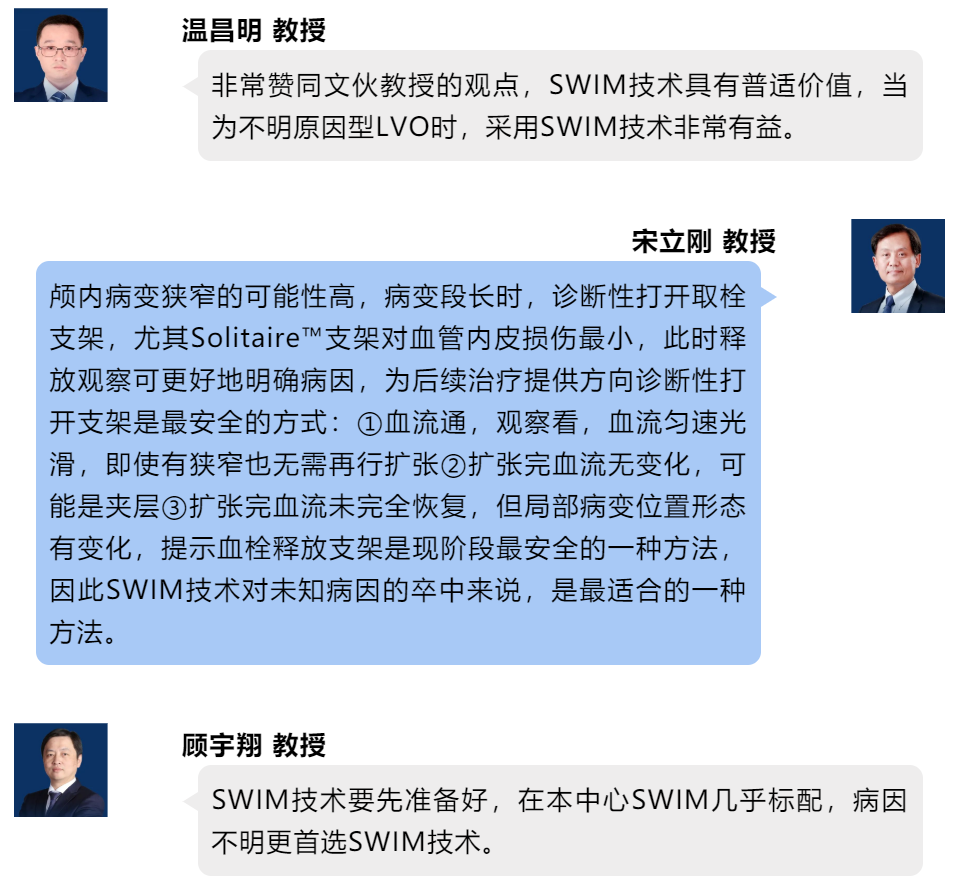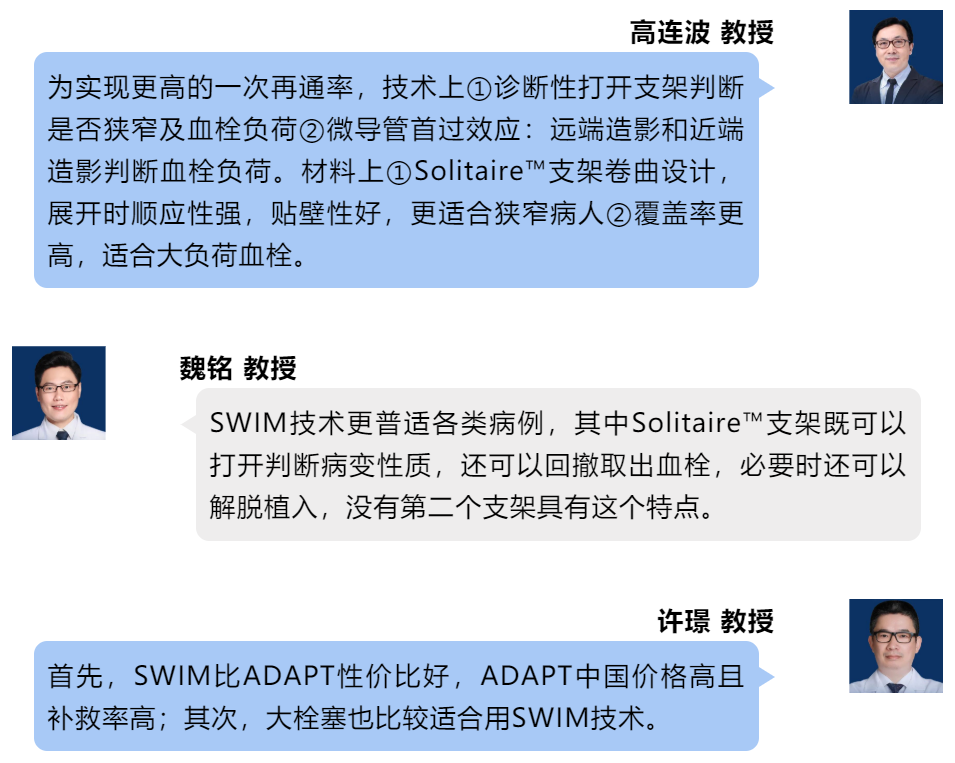

回顾打赢急诊取栓遭遇战的思辨攻略,陈文伙教授在“思辨二:经评价可以行机械取栓,但无法充分辨识病变时,应首选什么治疗方案”中提到,作为首个中国神经外科领域和神经介入领域登录《新英格兰医学杂志》的重磅原创巨著,代表中国缺血性卒中治疗的最高水平的DIRECT-MT研究显示:直接取栓组和静脉溶栓桥接取栓组分别有37.0%和41.6%的缺血性卒中患者,经过术前临床检查和影像诊断仍不能明确病因。
认识不明病因缺血性卒中
急性缺血性卒中患者经过临床评估和影像学检查,大部分可明确病因,其他无法明确病因的,则称为不明病因卒中,或隐源性卒中[1]。2014年,Hart等[2]研究者们进一步将其细分为不明病因的栓塞性卒中(ESUS)。这些患者往往更年轻,缺乏常规危险因素,似乎没有明确的病因,包括颈动脉狭窄、心房颤动和心脏病病史,卒中病因可能为卵圆孔未闭、颈动脉网、凝血疾病、主动脉疾病、恶性肿瘤等等,但患者到院后常受限于急诊治疗窗口期,无法行更详细的检查于介入治疗前明确病因[3,4]。
不明病因缺血性卒中患者有多少
缺血性卒中患者中病因不明的比例范围7%至42%,取决于卒中人群的年龄分布和中心检查手段[5]。欧洲人群调查显示,约有1/3的短暂性脑缺血发作和缺血性卒中患者不明病因,即每年约40万例[6]。牛津血管研究OXVASC显示,32%的缺血性卒中病因不明,虽然这些患者动脉粥样硬化危险因素较少,但具有与非心源性卒中人群相似的预后[7]。MR CLEAN最新发表的亚组研究显示,在行机械取栓的患者中,高达49%病因不明,高于心源性栓塞(33%)和动脉粥样硬化狭窄,且血栓CT特征与心源性相似[8]。TIMS-China报道其国内发生率11.7%,积极治疗可获得与明确病因的患者同样的良好预后[9]。
不明病因缺血性卒中怎么治疗
针对不明病因的急性缺血性卒中,考虑其并不是一个诊断学分类,而是许多病因的集合,尽可能完善检查、明确病因仍是必要手段,譬如颈部CTA[10]、胸部CT、经食道心脏超声[11]等。然而,当前并没有针对该类患者的最佳术前检查策略,不同卒中中心的检查设备、时间限制,及采用了广泛的检查手段仍未发现明确病因者,不能耽误对其的及时治疗。抗凝治疗[9]已被证实对于病因不明的卒中患者同样有效,然而风险同样存在,从有限的试验数据来看,对于非狭窄性动脉粥样硬化,或主动脉弓内严重动脉粥样硬化引起的反复血栓栓塞事件,抗凝治疗效果并不佳[12,13]。近期随机对照抗凝治疗研究[14,15]的阴性结果亦提示,心源性栓塞包括隐匿性房颤,可能仅占病因不明卒中患者中相对较小的部分[16]。国内最新研究中,使用72小时监测和超声排除隐匿性房颤和卵圆孔未闭后,仍有27.73%的卒中患者原因不明,且临床表现与动脉粥样硬化性脑梗塞相似,病变分布与心源性相近,提示这类患者的病因病机更复杂[18]。因此针对该人群的治疗必须充分考虑各种可能,使用最完善的治疗手段才能保障疗效和安全性。
MR CLEAN的另一个针对再次治疗的全国回顾性研究显示,即使病因不明,大部分急性缺血性卒中患者仍能从机械取栓中受益[17],再次治疗中最多见的则为心源性栓塞者。既往多个研究已证实支架取栓联合辅助抽吸,对于急性缺血性卒中大血管闭塞患者的疗效胜过单纯抽吸[19,20]。近年的真实世界研究更证实了抽拉结合技术具有更高的再通成功率(93.5% vs ADAPT 75.0%,p=0.006)和一把再通成功率(59.6% vs ADAPT 33.3%,p=0.019),且术中器械需要通过病变的次数更少[21]。
不明病因的急诊取栓采取SWIM技术的临床优势
于中国沃土诞生的SWIM技术,以循证基石Solitaire™支架为基础,辅助导管负压抽吸,站在循证巨人的肩膀上,取各方优势于一体,是唯一能够应对各种病因、病变大血管闭塞性急性缺血性卒中的利器。即使对不明病因的急性缺血性卒中患者,SWIM技术也可完全地应变,兔子偏由狮子搏,在充分保障安全性的前提下帮助术者达到最大的疗效,最大限度地提升广大卒中患者的临床预后。



请点击下方视频,观看《打赢急诊取栓遭遇战的思辨攻略》——思辨一:取栓遭遇战,有哪些评估流程和手段有助于充分辨识病变?
官是先锋得,材缘挑战须。
身轻一鸟过,枪急万人呼。
第二期 “美力有约 鸿儒思辨” 专家团激情思辨在前,后续衍生解读继续,若问取栓遭遇战如何打,一本《思辨攻略》伴君行。在时间窗允许的情况下充分完善检查,仍不明病因的急性缺血性脑卒中患者,机械取栓首选SWIM技术。
1. Saver JL. Crytogenic stroke. N Engl J Med.2016;375:e26.
2. Hart RG, Diener HC, Coutts SB, et al. Embolicstrokes of undertermined source: the case for a new clinical construct. LancetNeurol. (2014)13:429-38.
3. Alsheikh-Ali AA, Thaler DE,Kent DM. Patent foramenovale in crytogenic stroke: incidental or pathogenic? Stroke.2009;40(7):2349-55.
4. Miranda B, Fonseca AC, FerroJM. Patent foramen ovaleand stroke. J Neurol. 2018;265(8):1943-9.
5. Hart RG, Catanese L, Perera KS,et al. Embolic stroke ofundetermined source: a systematic review and clinical update. Stroke.2017;48:867-72.
6. Amarenco P. Cryptogenic stroke, aortic archatheroma, patent foramen ovale, and the risk of stroke. Cerebrovasc Dis2005;20(suppl 2):68-74.
7. Linxin Li, Gabriel S. Yiin, Olivia C. Geraghty, onbehalf of the Oxford Vascular Study. Incidence, outcome, risk factors, andlong-term prognosis of cryptogenic transient ischaemic attack and ischaemicstroke: a population-based study. Lancet Neurol 2015;14:903-13.
8. Nikki Boodt, Kars C.J. Compagne, Bruna G. Dutra, onbehalf of the MR CLEAN Registry Investigators. Stroke etiology and thrombuscomputed tomography characteristics in patients with acute ischemic stroke. AMR CLEAN Registry substudy. Stroke. 2020;51:1727-1735.
9. Yu Fan, Xiaoling Liao, Yuesong Pan, on behalf of theTIMS-China Investigators. Intravenous thrombolysis is safe and effective forthe cryptogenic stroke in China: data from the thrombolysis implementation andmonitor of acute ischemic stroke in China (TIMS-China). Journal of Stroke andCerebrovascular Diseases, Vol. 28, No. 1 (January), 2019:pp220-226.
10. Yang Yu, Baozhen Wang, Shugang Zheng,et al. Carotid web andischemic stroke: a CT angiography study. Clinical Imaging 67(2020):86-90.
11. Jing Yang, Huiqin Zhang, Yumeng Wang, et al. TheEfficacy of contrast transthoracic echocardiography and contrast transcranialdoppler for the detection of patent foramen ovale related to crytogenic stroke.Biomed Res Int. 2020 May 27;2020:1513409.
12. P. Amarenco, S.Davis, E.F. Jones, Clopidogrel plusaspirin versus warfarin in patients with stroke and aortic arch plaques.Stroke. 45(2014):1248-1257.
13. R.L. Sacco, S. Prabhakaran, J.L.P. Thompson, WARSSinvestigators. Comparison of warfarin versus aspirin for the prevention ofrecurrent stroke or death: subgroup analyses from the Warfarin-AspirinRecurrent Stroke Study. Cerebrovasc. Dis. 22(2006):4-12.
14. Kasner SE, Swaminathan B, LavadosP, et al. Rivaroxaban oraspirin for patent foramen ovale and embolic stroke of undetermined source: aprespecified subgroup analysis from the NAVIGATE ESUS trial. Lancet Neurol.(2018)17:1053-60.
15. Healey JS, Gladstone DJ, Swaminathan B, et al.Recurrent stroke with rivaroxaban compared with aspirin according to predictorsof atrial fibrillation: secondary analysis of the NAVIGATE ESUS randomizedclinical trial. JAMA Neurol. (2019)76:764-73.
16. Ursula G. Schulz. Crytogenic stroke -How to makesense of a non-diagnostic entity. Maturitas 122(2019):44-50.
17. France Anne Victoire Pirson, RobertJ. van Oostenbrugge, Wim H. van Zwan, et al. Repeated endovascular thrombectomy in patients withacute ischemic stroke. Stroke. 2020;51:526-532.
18. Weijing Wang, Xiaomei Tang, WeiLiu, et al. Clinicalfeatures of embolic stroke of undetermined source. Front. Neurol. 11:58. doi:10.3389/fneur. 2020. 00058.
19. Ryan A. Mctaggart, Eric L. Tung, Shadi Yaghi, et al.Continuous aspiration prior to intracranial vascular embolectomy (CAPTIVE): atechnique which improves outcomes. NeuroIntervent Surg. 2016. 012838.
20. Volker Maus, Daniel Behme, ChristophKabbasch, et al. Maximizingfirst-pass complete reperfusion with SAVE. Clin Neuroradiol. 13 February, 2017.
21. Alex Brehm, Volker Maus, IoannisTsogkas, et al. Stent-retrievalassisted vacuum-locked extraction(SAVE) versus a direct aspiration first passtechnique (ADAPT) for acute stroke: data from the real-world. BMC Neurology.(2019)19:65.




